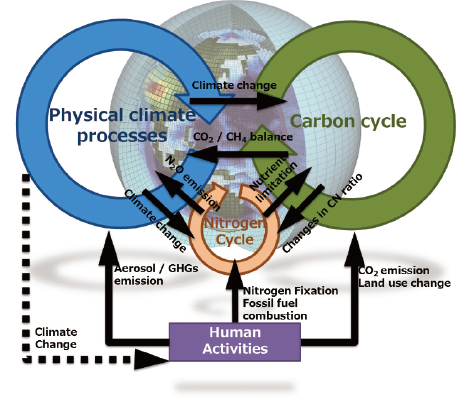The IPCC's Fifth Assessment Report (2013) revealed the temperature rise due to global warming to be in good proportion with the cumulative emission of anthropogenic carbon dioxide. This relationship can be used to estimate total acceptable emissions if society is to achieve the 2°C target. About two thirds have already been emitted of total emissions thus estimated. This leads to the understanding that achieving the 2°C target or the 1.5°C target mentioned in the Paris Agreement will not be easy at all, however, the uncertainty involved in the estimate is also quite large. The exact value of the estimate can lead to huge differences in the cost of global change mitigation and thus drastic changes in what future society will be like in terms of energy production and consumption.
The "Earth System Model" (ESM), a climate model that utilizes biological and chemical processes, is used in computing total overall acceptable emissions and examining all the associated uncertainties. Theme B involves further development of ESM via the introduction of the new biogeochemical processes that are needed in more sophisticated global change projections, for example nitrogen and methane cycling, improving the physical processes involved with the atmosphere and oceans in thereby enabling the performance of more elaborate evaluations, and taking into account the interaction between human activities and the Earth system. We will also work on simulation studies for use in evaluating the effectiveness of artificial control of the climate such as scattering sunlight by distributing fine particles throughout the atmosphere in order to slow down the global change. In addition, keeping an eye on abrupt changes in the Earth system, for example the collapse of the Antarctic ice sheets, with which the probability may be low but the damage gigantic, will be necessary. Through these activities Theme B aims to contribute to international efforts to establish a pathway to mitigating global change, including the Climate Change Framework Convention, which entered a new phase with the Paris Agreement.
| Subject | Representative | |
|---|---|---|
| (ⅰ) Development of ESM and analysis of the Earth system | ||
| a | Development and application of ESM | Tomohiro Hajima Japan Agency for Marine-Earth Science and Technology, Deputy Research Unit Leader |
| b | Stochastic assessment of temperature rise via multi-model analysis | Junichi Tsutsui Central Research Institute of Electric Power Industry, Duputy Associate Vice President |
| c | Organization of ESM development environment | Takashi Arakawa Research Organization for Information Science and Technology, Senior Researcher |
| (ⅱ) Earth-human system interaction | ||
| a | Earth - Socioeconomic System interaction | Kaoru Tachiiri Japan Agency for Marine-Earth Science and Technology, Unit Leader |
| b | Earth System - water resource/crop/land utilization model linkage | Tokuta Yokohata National Institute for Environmental Studies, Senior Researcher |
| (ⅲ)Technical and clerical support for inter-theme cooperation | Michio Kawamiya Japan Agency for Marine-Earth Science and Technology, Director |
|

